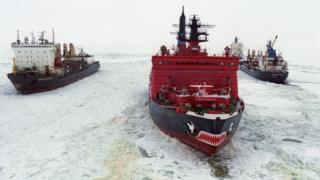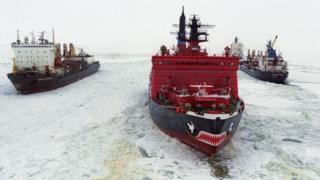Russia’s Taymyr plan: Arctic coal for India risks pollution
A huge wildlife haven is at risk as Russian coal ships exploit melting Arctic ice in Siberia. …

 Image copyright Getty Images
Image copyright Getty Images Natural riches come in two conflicting types in Russia’s Arctic north: valuable minerals and spectacular wildlife.
But sadly for many threatened species, the decline in Arctic sea ice has created a new economic opportunity for Russia in their remote habitat.
In a decree last year President Vladimir Putin ordered Russian firms to boost cargo traffic on the Northern Sea Route to an annual 80m tonnes by 2024.
Ambitious energy co-operation deals were signed with India in Vladivostok, in Russia’s far east, in October.
One centres on a big open-cast coal mining project in the Taymyr Peninsula, in the far north of central Siberia.
The area is rich in high-quality coking coal (anthracite), used to make steel and aluminium.
Dharmendra Pradhan, India’s Minister of Petroleum and Natural Gas, said: “We are the second largest coal importer in the world, and we intend to achieve production of 3m tonnes of steel per year by 2030, so we need to increase coal supplies.”
But Taymyr is a haven for wildlife. It has Russia’s largest nature reserve – Bolshoi Arkticheskiy – covering 4.2m hectares (16,200 sq miles).
On TV President Putin presents himself as a caring conservationist, famously relaxing in Siberia’s unspoilt wilderness.
But he is also championing the expansion of fossil fuel projects in that wilderness.
Russia is boosting trade with China, India and other growing Asian markets hungry for raw materials. Coal is to contribute to meeting that 80m-tonne target for Arctic deliveries, which will go via Russia’s far east.
But such shipments pose considerable risks.
Despite global warming, icebreakers still play a key role, as winter temperatures plunge below minus 20C. Remote settlements lack equipment to deal with any pollution emergency. And long voyages to India will mean more greenhouse gas emissions from shipping.
The Arctic is estimated to have 72% of Russia’s total gas reserves. Oil and gas mega-projects are far advanced further west, notably on the Yamal Peninsula.
In Taymyr the coastal tundra – marshland with permanently frozen subsoil – is a nesting ground for migratory birds, which fly there for the brief Arctic summer.
Polar bears sometimes come ashore on Taymyr while, inland, vast reindeer herds roam and snowy owls hunt lemmings.
Along with the pollution threat, reindeer are now seriously threatened by poaching, says Alexey Knizhnikov, a conservationist at WWF Russia.
“Developing new projects in such an ecologically sensitive area is madness, in our view,” he told the BBC.

Media playback is unsupported on your device
There is already pollution with heavy metals and sulphur dioxide (SO2) around the city of Norilsk, from the Norilsk Nickel ore smelter.
A Greenpeace study published in August said: “In terms of individual hotspots, the Norilsk smelter complex continues to be the largest SO2 emission hotspot in the world.”
It also found India to be the world’s top SO2 emitter.
Now a bay just south of Dikson – a tiny weather-beaten port and one of the world’s remotest settlements – is a new, ecological danger zone.
An anthracite coalfield lies at Medusa Bay, part of the Bolshoi Arkticheskiy nature reserve.
The bay attracts big flocks of birds, including six rare or endangered species: the small swan, peregrine falcon, gyrfalcon, white-headed loon, white-tailed eagle and red-breasted goose.
The open-cast coal company, Vostokugol, is embroiled in a legal battle with the state environmental monitoring agency, Rosprirodnadzor, over mining violations.
Vostokugol is appealing against a ruling that it abused the licensing system: a Moscow court found it had mined and exported coal from Medusa Bay, yet only had permits for prospecting. It was fined 601m roubles (£7.3m; $9.4m).
The company has a joint production deal with Coal India Limited, an industrial giant.
Meanwhile, Greenpeace urged Russia’s chief prosecutor in August to intervene, after the Russian Ministry of Natural Resources more than halved the size of a buffer zone protecting Medusa Bay nature reserve.
The zone – where mining and related construction are banned – was reduced to 1,150 hectares (2,842 acres), from 3,020 ha.
That government move in July came despite a 2016 plea from the ministry itself and the Taymyr nature reserve authority to site a planned new coal terminal well away from the reserve.
In line with Mr Putin’s Arctic ambitions, Vostokugol is developing – albeit slowly – the Medusa Bay coalfield and two coal terminals for loading on to ships.
Greenpeace says the Chaika terminal is just 1km (0.6 miles) from the nature reserve. “At that distance, when coal is loaded at the terminal, coal dust will pour down on the nature reserve,” says the Greenpeace legal complaint against the natural resources ministry.
Vostokugol plans to export 20m tonnes of coal from there by 2024. Another firm, Severnaya Zvezda, also has licences to mine coal in Taymyr.
Vostokugol started mining and building infrastructure at Medusa Bay in 2016, but later suspended operations. The company did not respond to the BBC’s questions.
Just 2km from the open-cast coal mine stands an international bird monitoring centre – the Willem Barents Biological Station. It was set up with Dutch government funding in 1994.
Dr Sergey Kharitonov, a biologist, was there last year. Coal dust from the mine had already reached as far as Dikson, he told the BBC.
“The bird populations are in danger, I’m worried about their future,” he said. “The place has lots of coal, and it’s apparently easy and profitable to mine it.”
WWF’s Alexey Knizhnikov said “there is little transparency in this project – there is a lack of regulation and they didn’t do any public consultations”.
Strategic priorities however are driving this mining and energy extraction in the polar wilderness.
Russia is the world’s third-largest coal exporter (210m tonnes in 2018), after Indonesia (439mt) and Australia (382mt), the World Coal Association reports.
Read related stories on similar topics:
India has become increasingly dependent on imported coking coal for metallurgy, says Rohit Chandra, a coal expert at Delhi’s Centre for Policy Research.
Russia aims to boost its coal exports to India six-fold by 2025, to 28m tonnes annually.
Mr Chandra told the BBC such a volume was “realistic – it’s not massive by international standards”. China consumes vastly more coking coal than that every year.
He noted that even back in the 1970s the then-communist Russian state had been helping India to industrialise.
“India’s co-operation with Russia is deeper than with other coal-exporting countries,” he said. “It’s a reliable partner, and there are lots of other commercial deals [with Russia].”
Moreover, he said, “renewable energy is not replacing traditional power sources any time soon in India”.


